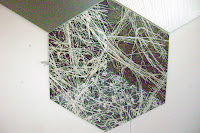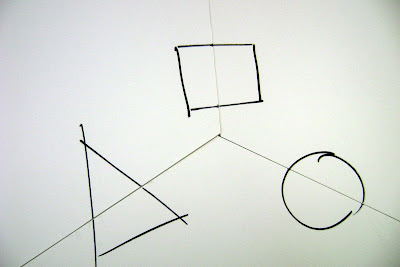
Plan A : Cutting on flat bed saw: To cut identical diamonds on a flat bed saw as per the cutting diagram illustrated. This involves making a perfect diamond template for setting the flat bed saw.
Outcome: It seems that perfect diamonds are not possible with the machine chosen as such fine calibrations are beyond its capability.
Plan B: laser cutting: Investigate C&C computer cutting machine on campus. The relevant staff were unavailable at time of writing, so input from Harry Redward, Building 76 was sought regarding the suitability of the project to Laser cutting on campus.
Outcome: There are two challenges: the planned wallboard product is not suitable for laser cut in Building 1 on account of harmful volatiles released during the cutting process. The same applied to custom wood. The only product permitted is plywood - a prohibitive $40 per sheet plus delivery. also the smaller bed size would result in a poorer cut-out rate.
Plan C: re-frame the problem: I considered the notion that the internal cuts that matter the more than the outside cuts, and that if one was to make hexagons, and cut 3 lines to meet at the centre, they must go back together as they have just been cut together. A discussion with David Chaplin from the school of Architecture, raised the issue of 'tolerances' in construction, and of how they must always be allowed for in structures. The one problem with this plan is - as they shapes are destined to be tessellated together, accuracy of all joins is vital.
Plan D : alternative supplier of laser cutting. An off-campus company, has been suggested as having more suitable volatile extraction equipment, and the ability to to take full sheets of materials. At time of writing a quotation is being sought.
 Preparation for substrarte addition.
Preparation for substrarte addition. Feeling the theme was getting lost in 'surface' layers of creation, I feel the need to reassert the emphasis on cosmic substrate and to keep the surfaces in context. This mega-molecule arrangement is informed by incomplete NASA type photo-surveys of other planets as well as by subatomic and molecular structures. This also deviates away from the block arrangement we are accustomed to with traditional tessellated tile arrangements. The 3 D tones will be achieved with the tinted matt, gloss and satin technique.
Feeling the theme was getting lost in 'surface' layers of creation, I feel the need to reassert the emphasis on cosmic substrate and to keep the surfaces in context. This mega-molecule arrangement is informed by incomplete NASA type photo-surveys of other planets as well as by subatomic and molecular structures. This also deviates away from the block arrangement we are accustomed to with traditional tessellated tile arrangements. The 3 D tones will be achieved with the tinted matt, gloss and satin technique.




























 Part solution: An off campus laser cutting company has offered to cut one sheet of wallboard for $45 - providing me with 5 cubes. Sufficient for now. I suspect I will have these 5 before I could
Part solution: An off campus laser cutting company has offered to cut one sheet of wallboard for $45 - providing me with 5 cubes. Sufficient for now. I suspect I will have these 5 before I could 

 Meantime: While waiting for what I will make 3 works using white foamboard to determine what is to be learned about making corrections. Also I can prepare how to lay out the room in prep for a large number of items being painted and dried with undercoat. A key will ensure correct assembly.
Meantime: While waiting for what I will make 3 works using white foamboard to determine what is to be learned about making corrections. Also I can prepare how to lay out the room in prep for a large number of items being painted and dried with undercoat. A key will ensure correct assembly. 















